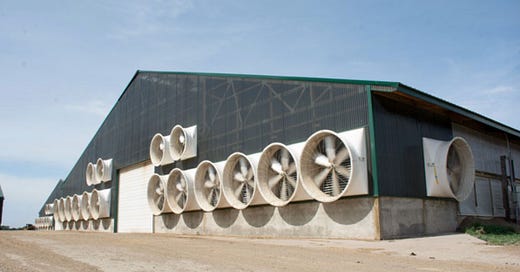A chicken gift to the dairy biz
Prime Future 170: the newsletter for innovators in livestock, meat, and dairy
There's a cutting-edge innovation in the dairy industry: tunnel-ventilated barns.
The equipment co Munters lays out some relevant background:
“For the past 20 years, it has been well known that heat stress in high-production dairy cows impacts milk production, fertility, health, and even the milk’s quality. During this period, researchers and farmers came up with various climate control concepts. Most of these ideas were based on cooling the cows directly. This approach solved the basic issues and worked in different countries but it created other challenges: large amount of wasted water (including water that spills into the area in which the cows are standing), extra work, and significantly higher electrical costs.”
Enter the brand new idea of cross or tunnel-ventilated barns for dairy cows, effectively creating air movement and negative pressure through the use of exhaust fans in a completely enclosed barn to create a cooling (or warming) effect.
There are multiple reasons these are becoming industry standard for newly constructed dairy barns. Here's how one industry friend described the benefits:
1. Size and scale advantages. You can get a lot of cows in a small footprint and they are labor and capital efficient. No other housing option allows you to scale up like a cross-ventilated barn. It's only recently that dairies have figured out how to get big, and other technologies like big rotaries, sort gates, etc. have made getting big possible. The efficiency reduces costs per cow or per cwt milk.
2. Better suited for methane digesters. In these barns, manure is more consistent year-round and not altered by sun, rain, wind (dirt), or freezing.
3. In cold climates, it is advantageous to have cows in warm barns; it is easier on animals and people. In warm climates, it is advantageous to keep cows cooler; easier on animals and people.
Except, of course, tunnel-ventilated barns are not at all a new concept.
They were used in the poultry industry as early as the 1970s. In fact, they’ve been the industry standard for decades in broiler, turkey, and swine production.
This is a fascinating dynamic; what’s brand new to one industry is old hat to another.
There has to be a case study here about how/why/when innovation transfers from one segment to another, especially within agriculture. Especially within animal protein.
Because there's something elegant about innovations that are borrowed ideas, the new-to-me kind that are tried and true elsewhere.
The rest of this edition is available only to premium subscribers. Shoutout to the many premium subscribers making Prime Future a sustainable thing.




